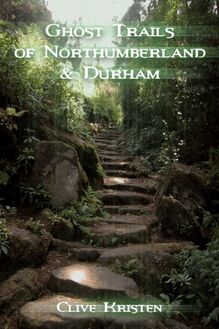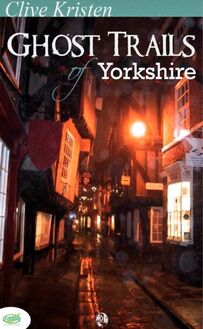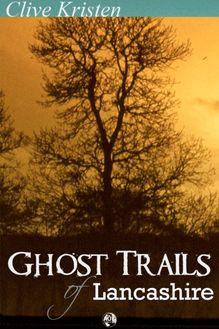Ghost Trails of Yorkshire , livre ebook
116
pages
English
Ebooks
2014
Vous pourrez modifier la taille du texte de cet ouvrage
Obtenez un accès à la bibliothèque pour le consulter en ligne En savoir plus
Découvre YouScribe et accède à tout notre catalogue !
Découvre YouScribe et accède à tout notre catalogue !
116
pages
English
Ebooks
2014
Vous pourrez modifier la taille du texte de cet ouvrage
Obtenez un accès à la bibliothèque pour le consulter en ligne En savoir plus
Publié par
Date de parution
10 juin 2014
Nombre de lectures
2
EAN13
9781849894364
Langue
English
Title Page
Ghost Trails of Yorkshire
Clive Kristen
Publisher Information
© 2011 Clive Kristen
This digital edition published in 2011 under licence to Andrews UK Ltd
This book is sold subject to the condition that it shall not by way of trade or otherwise, be lent, resold, hired out or otherwise circulated without the publisher’s prior written consent in any form of binding or cover other than that in which it is published and without a similar condition including this condition being imposed on the subsequent purchaser.
Author’s Note
With a few exceptions – Skipton, Ripon, York, Rosedale Abbey and Amazing Abbeys – this book contains rural ‘tour and explore’ trails linked by supernatural themes. The trails have been constructed to take advantage of the geography of the region and to bring its rich cultural and historical heritage to life. The idea is to get out there in the countryside and cover the trail on the ground.
All of these trails can be accomplished in a day – albeit some may require a fairly brisk schedule. For those who prefer more relaxed ghost hunting each trail can be conveniently broken down into sections. Some of the longer trails could easily be extended to three or four days. A good map would be regarded as a valuable companion.
Whilst every effort has been made to provide accurate historical and topographical detail the reader will understand that no area of human consciousness is more prone to misinterpretation and confusion than the supernatural.
In an attempt to make sense of this dilemma this book tries to balance traditional accounts with archive and historical material and the common sense of local knowledge.
I am indebted to archivists and librarians in the UK and abroad without whose patience and perseverance this would have been a much smaller volume. An acknowledgement list is included at the end of the book.
I am also grateful to those who have written to my former publisher or who have taken part in supernatural phone-ins on local radio. I also wish to record as debt of gratitude to those who have given permission for their stories to be retold.
Again my greatest debt is to my wife for her encouragement, ghost hunting skills, and infinite patience.
Clive Kristen
May 2012
About the Author
Former teacher and lecturer, Clive Kristen, joined the ranks of professional writers 20 years ago. He was born in Lancashire, went to school in Yorkshire and now lives in rural Northumberland.
Clive achieved some notoriety as the creator of the folk club standard The Phantom Flasher - a character who had no supernatural provenance whatsoever. The Ghost Trail series began with Ghost Trails of Northumbria. This title was followed by More Ghost Trails of Northumbria and a companion volume - Murder and Mystery Trails of Northumbria. The most popular in the series to date - Ghost Trails of the Yorkshire Dales - appeared in 1994. A Fourth Ghost Trails book – featuring South Yorkshire was published in 1998. Many of these stories have been retold by the author on the Tyne Tees TV Tonight programme. Much of this material, plus updates and new stories, appears in this compendium.
The author has also been responsible for How To Buy and Rent Property in France - a specialist guide offering independent advice for those considering the advantages of property on the warmer side of the channel. Two French property based sequels followed. Clive was also co-author of Beyond Endurance - Captain Nick Barker’s account of the Falklands Conflict. His detective story/biography (of his father) Fucking on Fridays has been published as an ebook. A first novel - Frost and Fire is in preparation.
Jonah Fark
Taking Care in Town and Country
Most of the sites mentioned in this book can be accessed from public rights of way. Where this does not apply ghost hunters can get a good impression of the site from suggested viewpoints.
Where land is farmed it should be treated with particular respect. In a few cases access is restricted and the necessary consents should be obtained. Special care is required during the lambing season and ghost hunters are requested to follow the country code guidelines.. Please follow footpaths, close gates, and keep dogs under close control. Litter is unsightly and can cause injury to animals.
Some of the buildings mentioned are private homes. Please do not trespass or behave intrusively. Property owners have been generous in the information they have provided. Please ensure that their quiet and privacy is preserved.
These tours are designed for the motorist and little of the walking required can be described as arduous. Nevertheless Yorkshire weather is notoriously unpredictable -even in summer. It is suggested that ghost hunters do not travel alone and have adequate footwear and a waterproof garment.
Clive Kristen
The Northern Dales
Kirkby Stephen is all too often ignored by visitors to the region. In part this is explained by its fringe position and, even by Dales standards, isolation.
This small town is surrounded by some of the least hospitable terrain in the UK. To the west is Ravenstonedale and ‘wild’ West Fell - a delight during the few weeks that pass for summer. To the north-east is Stainmore - a desolate spot where the curtains were drawn on the Kingdom of Northumbria in AD 954. To the south is Wild Boar fell, once perhaps the last wilderness in England, and the Mallerstang Valley which contains the slight remains of Pendragon Castle - said to be the fortress of Uther Pendragon, King Arthur’s father.
All this has shaped Kirkby Stephen. It is a sturdy grey place that echoes the wilds that surround it.
The Games People Play
One of the finest old buildings is now owned by Penrith Farmers Estate Agents. It is a former butcher’s shop which features a 17 th century gallery.
A local tradition has it that a former butcher’s wife revenged herself on an unfaithful husband by taking a meat cleaver to him. She escaped punishment for the crime by claiming he had deserted her. By the time the authorities heard whispers of something more sinister, the last pie had been sold and eaten.
She maintained to her dying day that the errant husband took naught but his woolly coat and departed. However, a suspicion remains that he is perhaps more likely that he left the shop wrapped in a muslin bag and flaky pastry.
Less than a century ago there were reports of poltergeist activity at a house now numbered 89 High Street.
Plates and ornaments went into self-destruct mode, and clocks in the house regularly stopped at a quarter to midnight. Even more oddly it seems that an assortment of objects - from keys to candles - would disappear only to turn up a few days later. An exorcism was carried out, and a contemporary account claimed ‘these ministrations stilled the unseen hand.’
In local folklore those out after eight o’clock in the evening were likely prey for the demon Taggy. As a warning to all the Taggy Bell was traditionally rung from the parish church at the evening curfew.
Of course there were those who would brave the wrath of the demon if the ‘rewards’ seemed to be worth it. Courting couples were once said to be ‘shirking Taggy’ and regulars at the public houses had to ‘hie from Taggy’. Both expressions died out from popular usage around the turn of the 20 th century.
Confusing and contradictory accounts do little to establish any meaningful form or impression of Taggy. The word was used up to the 17 th century to indicate a troll-like boggart whose preferred diet was peat-roasted human flesh. By the 18 th century however it had come to suggest a more ethereal demon that dealt mischief to those it caught wandering after dark.
Fear has long been the European way of instilling discipline and obedience in young people. One of the simple joys of parenthood is to pass on the nightmares of youth to the next generation. ‘Taggy’ is probably little more than the Kirkby Stephen version of a thorn almost universally sown into the garden of the young mind.
Hartleys, Musgraves & Whartons
Kirkby Stephen Parish Church contains the tomb of Sir Andrew de Harcla (otherwise Harclay or Hartley). Sir Andrew was a local hero. This fine old building also contains some notable Musgrave tombs, including that of Richard, the man who is believed to have killed the last wild boar in England.
This has been a place of worship for more than eleven centuries, although the present building dates from around 1220. Perhaps the most notable relic to be found in the church is the 10th. century Loki Stone. This is a carved Anglo-Danish cross shaft which features a hirsute chained devil said to represent Loki - a Viking god. This pre-conquest symbol of the devil in human form is one of only two known to exist in Europe.
The Hartley Chapel denotes the importance of this family in local history. The name is derived from de Harcla.
The Wharton Chapel contains the tombs and effigies of Thomas - the first Lord Wharton - and his two wives. The Whartons have been major local benefactors and indeed it was the first lord who founded the grammar school in 1566. The fourth Lord, Philip, began the distribution of bibles to children - a tradition that continues to this day.
The ghost of a nobleman has been spotted at various points along what is now the A685. The spectre is said to be that of the evil Lord Wharton, former Lord of the Manor and President of the Peculiar Court of Ravenstonedale.
Lord Wharton was in fact very much a law unto himself. He committed terrible crimes again


